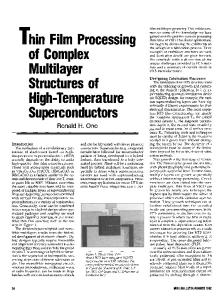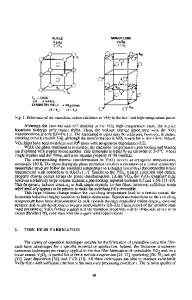Polymer Multi-Layer Processing of Thin Film Materials
- PDF / 457,846 Bytes
- 8 Pages / 391.5 x 607.5 pts Page_size
- 102 Downloads / 339 Views
Sigma Technologies International, Inc., 10960 N. Stallard Place, Tucson, AZ 85737 ABSTRACT
Polymer Multi-Layer (PML) processing is a high speed industrial scale process for depositing thin polymer films. Moving substrates of arbitrary width can have one micron (typ.) polymer films deposited at speeds measured in hundreds of meters per minute. A wide variety of chemical functionality available in the precursor materials allows a variety of chemical, electrical, and optical applications. The polymer characteristics can be further augmented by subsequent deposition of inorganic materials. Recent advances with dielectric, electrolytic, photonic, barrier, chemical affinity, energetic, and piezoelectric thin film polymer materials are discussed. INTRODUCTION
The Polymer Multi-Layer (PML) process' has been used for high rate deposition of thin film polymers for a number of different applications. The PML process uses vacuum deposition methods to produce pinhole free polymer films coatings of a well regulated thickness. In combination with the polymer film, metallic films are frequently deposited over the top of the polymer to accommodate electrical applications.
One PML deposition process is shown schematically in Figure 1. The process starts by pumping a liquid acrylate monomer into a flash evaporation apparatus inside a
I
CIW= E-Byem
Mno*w w
If*wni. ___._
vacuum chamber pumped with a diffusion pump to a base pressure of 10.' T2 The monomer vapor is ejected through a directional nozzle onto a moving cooled
Drum
Monomer
mom Ma"
substrate. The liquid monomer film is moved under a broad electron beam where it is cross linked into a solid polymer film. Subsequently, in the same revolution, a metal layer can be deposited. The polymer layers are typically
---
lomizer
VOW=
r
1 gam thick and metal
Polymer multi-layer (PML) layers are typically 500 A thick. As the drum Figure 1. processing chamber. rotates, successive polymer/metal bilayers can deposited on each revolution. The drum can rotate at surface speeds as high as 1000 f./min (5 m/s), that leads to the formation of multilayer structures with thousands of layers in periods of less than 1 hour. There are two main modes of PML production, namely web and multilayer (multilayer production is shown in Figure 1). In the web mode, a rolled film substrate is unwound in the vacuum chamber and directed onto a large rotating drum. The rotating drum moves the substrate 247
Mat. Res. Soc. Symp. Proc. Vol. 555 ©1999 Materials Research Society
past the polymer and other deposition stations and the film is then wound up on a take-up reel. This deposition results in rolls of film with modified surface functionality. The monomers used in this process have a wide range of compositions that are tailored for various applications. They must have the common characteristic of being flash evaporable, which usually means having a molecular weight of about 1000, and they must be sensitive to rapid cross-linking and free radical polymerization initiated with electron beam, ultra-
Data Loading...










